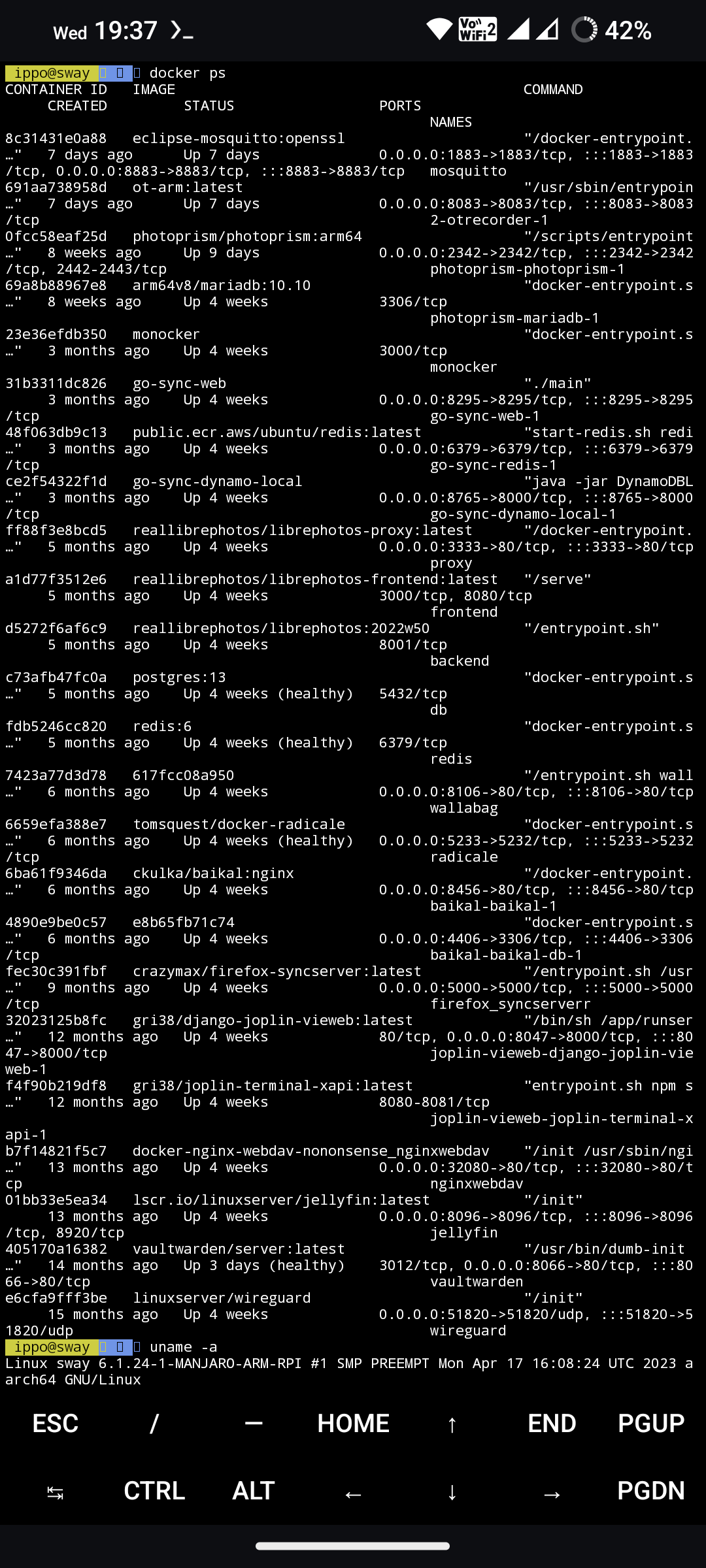For those of you who use Raspberry Pi’s in your home environment, I’m curious as to what you use them for. What applications are you running on them? Do you have your Pi’s setup in a cluster?
I own a raspberry pi 4. Every time I try to use it, I spend half my time trying to fix the stuttery/non responsive UI by fucking with the compistor and such. And then I give up.
I eventually got a new gaming PC and turned my old one into a Linux server, and haven’t really touched my Raspberry Pi since.
Try running a server image on it without desktop and then logging into it over the network from another device like a laptop via ssh
My usecase required a GUI. I was trying to have a mini PC connected to my TV to watch live sports games in a web browser (pirated streams). I was getting micro stutters with a raspberry pi, which made sports unwatchable.
I had similar problems doing the same thing with a Pi 4.
Lets see…
- nord vpn client
- qbittorrent (through nord vpn)
- proxy server (through nord vpn)
- wireguard vpn server
- ssh client so I can port forward through the vpn server to/from connected clients
- jellyfin
- ntfy (self hosted notifications)
- pi-hole (vital for the local dns)
- nginx
- gitea
- wallabag
- minecraft server
- container registery
- smb share for my friend (I help them with content creation)
- smb share for a live recording profile I set up on android
Those are just docker containers, it also is a backup server for all the devices I own. It also runs all non sensitive data on an unencrypted partition then will auto decrypt the sensitive partion through ssh via my desktop. This means my vpn server will always run so I can connect, wake on lan my desktop, decrypt it and log in. Im sure I’m missing things.
My list is very similar but I have my Pis in a k3s cluster with a NAS for PVs. That allows me to not worry about what physical device is hosting the service, and I built it so I can intermix amd64 devices when I start adding in my used laptops into the mix.
RPI4/400 is perfectly capable as a little home server. All it needs is a good SD card.
Owntracks,photoprism,monocker,brave go m-sync,libre photos,wallabag,radicals e,Baikal,Firefox sync,Joplin web,webdav server,jellyfin,vaultwarden,wireguard

Get an eMMC module ($10) for the Pi or buy something similar with one built-in. Much faster and more reliable.
I snagged an enclosure with a little adapter for a SATA m.2 drive. It’s amazing!
Hmmm, I’m just using OMV on mine to make it a server that I can use to transfer files around my house.
Do you have any tips on where I could get started doing more? I haven’t had success with Docker or Portainer and I’d love to have some software hosting files like OMV, and a torrent client running through a VPN in another container.
OMV is quite limiting and maybe a little heavy for the pi(?)
Docker is straightforward Idk what to say You install docker and docker compose on host and run some compose.yml’s to spin up your services
I feel old, I don’t understand 90% of words in this thread lol.
I just have kodi on Libreelec with a jellyfin plugin on my rpi4 and even that struggled with overheating at times. So I run most stuff on my pc instead. I’m tempted to try the portainer to get some experience with docker tho.
Removed by mod
I have k3s running on my Pi cluster and have dozens of services running on them. USB drives for the lot of them.
Removed by mod
Sure! I’m using ansible to manage the hosts, install k3s, and deploy the manifests. I’m looking at switching to nixos for reproducibility purposes. I have a couple Pi 4’s, and a handful of Pi 3Bs. Each one is booting off USB drives (Pi 4s have SSDs and others have thumb drives). Then I have an old computer I turned into a NAS server that is hosting NFS for the PVs of each pod. Then I have a rackmount gigabit switch, and I set up tailscale on each node, and reference everything by the tailnet names. Works really well and I have complete access while I’m away from home.
Edit: oh yea my NFS server is also hosting a docker server. My ansible stages the docker containers to the local docker server then each pod pulls from the local server to save on bandwidth and if internet goes down I can still do everything locally.
Really? I’ve seen threads with people claiming to run dozens of services on it. What do you recommend instead, just any rpi OS and installing them like I would on regular linux?
Removed by mod
I have 2 Pi 4s in operation. One is a Moonlight/USBoverIP stream gaming portal. It automatically turns on and connects to a VM running Sunshine on my Proxmox host, passes any USB controllers/bluetooth etc to the VM so the big loud gaming box is in the basement and the tiny Pi is next to the TV. 1080p60 works great, minimal lag.
The other acts mostly as a quorum server for the proxmox servers, I have two proxmox hosts and use the second Pi to ensure the cluster doesn’t get split brain. It also acts as a USBoverIP host for my home automation Zigbee and Zwave usb sticks, so that either proxmox host can connect to the USB sticks and the home automation VMs aren’t locked to a physical host.
deleted by creator
Are you using slskd, SoulseekQT or Nicotine++?
Only use it as a backup pihole now. Used to have an *arr stack on it, but needed a beefier pc
This lemmy instance is running on my Pi
I got a RPi 3B as my Pi-Hole that I’ll eventually use as my Wireguard VPN, too. Hoping to get another Pi device for hosting Jellyfin on.
I have one 3B running adguard and a wireguard vpn server. Another 4B doing the same, plus kitchenowl and home assistant.
Yes, it’s probably pretty demanding of the hardware but my Pi4 4GB runs:
- Heimdall
- Portainer
- Vaultwarden
- Flatnotes
- ownCloud
- FreshRSS
- Paperless
I bought a pi0 when I first started hosting things. It ran a pihole and piVPN instance for about 3-4 years before it died.
I would love to have another one, they are great pieces of hardware… but are just scalped to hell. I’ll keep buying old desktops and laptops with higher specs for cheaper until the costs go down.
Acronyms, initialisms, abbreviations, contractions, and other phrases which expand to something larger, that I’ve seen in this thread:
Fewer Letters More Letters DNS Domain Name Service/System HA Home Assistant automation software ~ High Availability HTTP Hypertext Transfer Protocol, the Web IP Internet Protocol MQTT Message Queue Telemetry Transport point-to-point networking NAS Network-Attached Storage NUC Next Unit of Computing brand of Intel small computers PiHole Network-wide ad-blocker (DNS sinkhole) Plex Brand of media server package RPi Raspberry Pi brand of SBC SATA Serial AT Attachment interface for mass storage SBC Single-Board Computer SSD Solid State Drive mass storage SSH Secure Shell for remote terminal access VNC Virtual Network Computing for remote desktop access VPN Virtual Private Network VPS Virtual Private Server (opposed to shared hosting) Zigbee Wireless mesh network for low-power devices nginx Popular HTTP server
[Thread #170 for this sub, first seen 27th Sep 2023, 16:05] [FAQ] [Full list] [Contact] [Source code]
I have four Pis. They’re running Pihole DNS & DHCP, a reverse proxy, and torrent clients. I don’t have them setup as a cluster, been meaning to look into it but I don’t want to add complexity so I’m putting it off.
I’ve been running OSMC (Kodi on Debian) plus a few useful things like maintaining a reverse SSH connection to a VPS.







